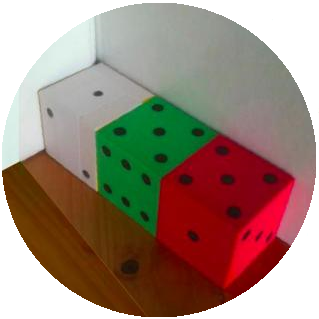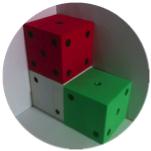Dice in a corner
How could you arrange at least two dice in a stack so that the total of the visible spots is 18?
Problem


Three dice are sitting in the corner with the simple rule that where two faces touch they must be the same numbers.
So, in the first picture above there are $3$s at the bottom of the red dice and on the top of the middle green and there are $4$s on the bottom of the green dice and the top of the white dice. The numbers on the seven faces that can be seen are then added and make $21$.
In the second picture above there are $4$s at the left of the red dice and on the right of the green dice and there are $3$s on the left of the green dice and the right of the white dice. The numbers on the seven faces that can be seen are then added and make $23$.
Use your own dice (you could use two or three or more...)
What total have you made?
Can you make a different one?
How many different ones can you make?
Now for a challenge - arrange dice (using at least $2$ and up to as many as you like) in a line in the corner, so that the faces you can see add up to $18$ in as many ways as possible.
Each line of dice must be along or up a wall (or two walls). A line going up is counted the same as a line going along. Remember the dice must touch face to face and have the same numbers touching. The dice must be all in one line, so this arrangement below is not allowed:

Getting Started
Don't forget that the face which are touching must be the same.
How will you make sure your arrangements are all different?
How will you know you have found all the different ways?
Student Solutions
Well done to everybody who found ways to make 18 using these dice in a corner. Kiran, Eeraj, Igla, Hassan and Ze-shaan from Crumpsall Lane Primary School in England investigated ways of making 18 using two dice:



Well done for finding so many solutions with two dice! The final picture is slightly unclear but this represents the solution:
2 4
4 2 6
Harry and Jack from Canberra Grammar School in Australia found four possible solutions using three dice:




Take a look at Harry and Jack's full solution to see their thoughts on this problem.
We received a solution from another Jack at Canberra Grammar School in Australia, who sent in these solutions for four and five dice:

Jack said:
I cannot show all pictures because the file size is too big!
That's a shame, Jack! I think there's one solution that nobody has found so far (that isn't just a rearrangement of one of the other solutions). If anybody thinks they have found it, please email us.
Teachers' Resources
Why do this problem?
Possible approach
Demonstrate the rule of "like faces facing", and then move the dice around a bit so that the rule is broken and ask if it's okay. Put the dice in the arrangement in the pictures and clarify how the total is calculated.
Before setting the children off on the challenge itself, you could ask them to find the smallest and largest possible totals for a stack of three dice so that they become immersed in the context.
Key questions
Tell me about this . . . .
How did you decide on this approach to finding all the possibilities?
Possible extension
How many ways are there for the most popular total?
Can you use a spreadsheet to get the results by using formulae rather than just entering data?
